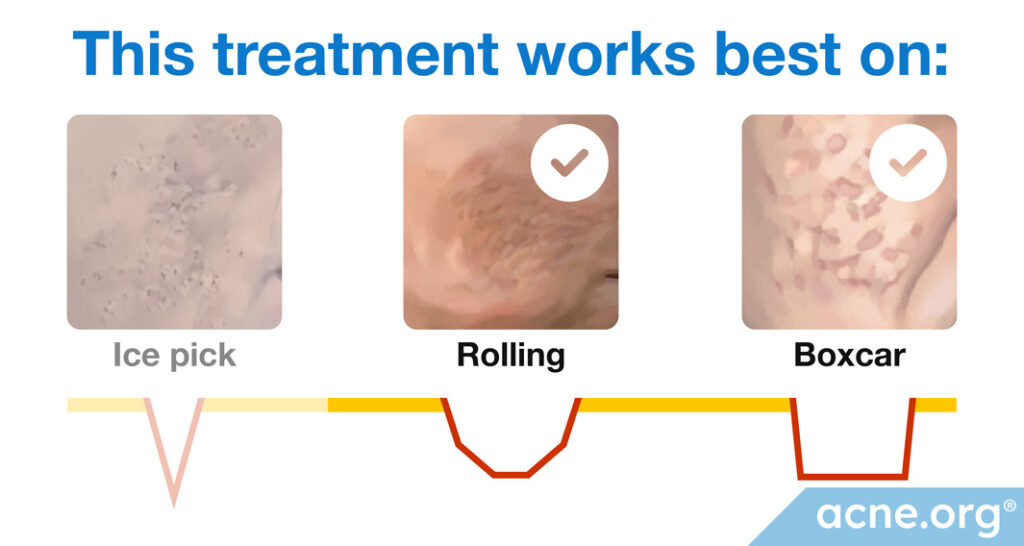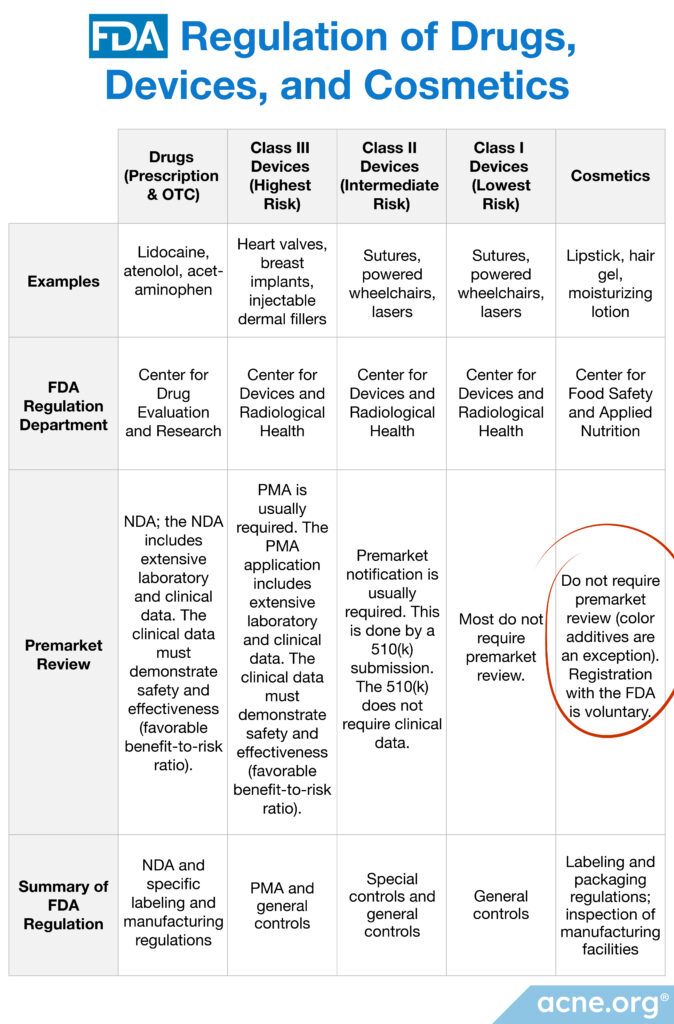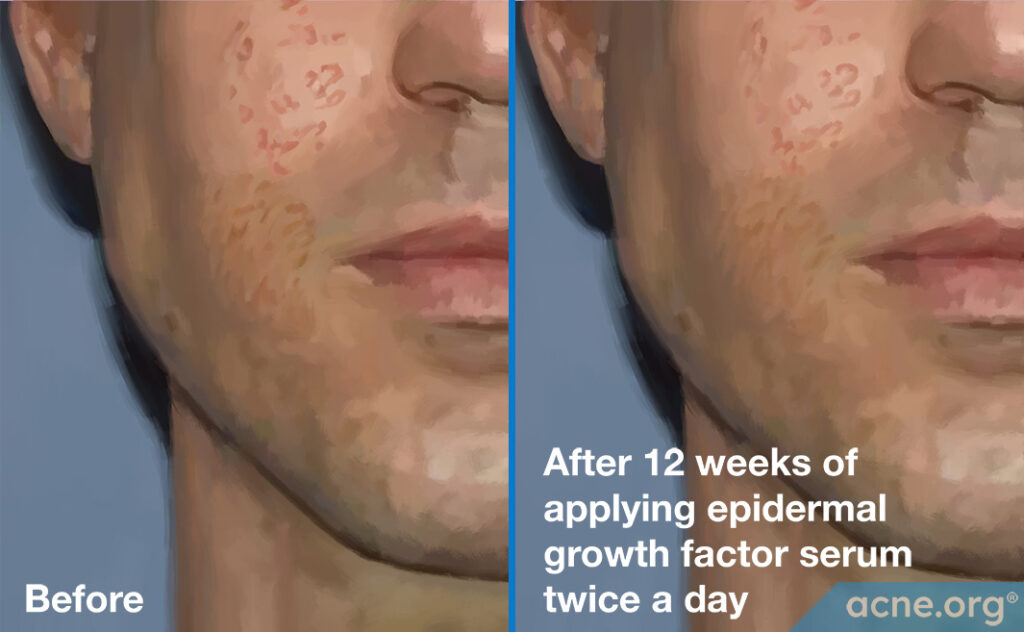
* There is no substantial scientific evidence that topical treatments improve the appearance of atrophic (indented) acne scars. There is a chance that some topical treatments, particularly prescription treatments, might help with shallow boxcar scars and rolling scars to a limited degree.
There are a variety of topical treatments on the market that claim to improve the appearance of atrophic (indented) acne scars. Most of these products are sold over-the-counter (OTC), but some are prescription.
Because the goal of topical scar products is to improve the appearance of scars rather than to resolve the scars, these products can technically be classified as cosmetics rather than drugs. Marketing topical scar treatments as cosmetics allows the manufacturers to bypass the review process that all drugs must undergo before they become available to consumers. In fact, in the United States, manufacturers do not even have to register cosmetic products with the Food and Drug Administration (U.S. FDA).1

Because most topical scar treatments never undergo rigorous review, we have no evidence that these treatments really work and almost no data on their potential side effects.
In a study published in 2009 in the Journal of the American Academy of Dermatology, a group of researchers investigated over-the-counter scar treatments and looked at the evidence for the efficacy of these treatments. The scientists found that most products did not have any evidence to back up their claims. The researchers even contacted the manufacturers of the various over-the-counter products. None of the manufacturers provided data from laboratory or clinical studies to show that their product effectively treats scars.1
Therefore, if you decide to try topical treatments for atrophic scars, proceed with caution. Read the product label and instructions carefully and be vigilant for potential side effects.
As with all scar treatments, topical products may be combined with other types of scar treatments to achieve desired results.
Unlike other scar treatments, some topical scar treatments such as topical retinoids can be used for acne treatment as well. If you experience active acne lesions with very shallow rolling or boxcar scars, you might consider starting with topical treatments.
Before beginning topical scar treatment, talk to your doctor about other acne scar treatment options that offer real benefits.
Procedure details:
Topical treatments for acne scars typically contain ingredients that are claimed to promote scar repair.
Over-the-counter treatments may contain one or more of the following ingredients:
- Onion extract: Onion extract is one of the main ingredients in Mederma®, a topical product marketed as a scar treatment. However, despite these encouraging results, studies done in humans have found no improvement of scars when using Mederma®.1
Laboratory studies conducted in vitro (in a test tube or petri dish, not in a living organism) suggest that onion extract might decrease inflammation (redness and swelling) and prevent infection, which means that it might theoretically help wounds to heal.3 Since an acne scar is a type of old wound, it may not be too much of a stretch to wonder whether onion extract might help to improve acne scars.
In addition, a study in rabbits showed that treating scars with Mederma® helped to improve the organization of collagen in the treated skin.1 Collagen is a skin protein that helps to make the skin smoother and more youthful, so theoretically, reorganizing collagen might smooth out acne scars.
- Vitamin E: Vitamin E is a common ingredient in over-the-counter topical scar treatments. Studies performed in humans have found that using Vitamin E did not result in improvement of scars.1,4 In theory, Vitamin E might be able to prevent abnormal scarring because of its antioxidant properties, but will most likely not help reduce the appearance of existing scars.
Prescription topical treatments for acne scars may contain one of the following ingredients:
- Topical retinoids*: Retinoids are substances derived from vitamin A. Topical retinoids include tretinoin, tazarotene, trifarotene, and adapalene. Retinoids are used to treat active acne because they can hinder two key processes in acne development: the clogging of skin pores and inflammation.5
Topical retinoids could also potentially help in scar repair because they stimulate the formation of collagen and improve the elastic fibers in the skin. More collagen and enhanced elastic fibers should mean smoother skin. However, so far, only one study has shown that using topical retinoids improved the appearance of facial icepick scars.2 However, because icepick scars are deeper, topical treatment is usually not used in icepick scarring. More research is necessary before we can conclude that topical retinoids are helpful in acne scar repair.
- Human synthetic epidermal growth factor (EGF): Epidermal growth factor (EGF) is a substance that stimulates skin growth and is naturally made by the body. Synthetic EGF is the same substance created in a laboratory. Human synthetic EGF is used in prescription topical treatments for hypertrophic and keloid (raised) scars. Because EGF plays a role in collagen production, it might help to repair atrophic (indented) scars as well. There is some evidence from two small studies that topical application of human synthetic EGF may improve atrophic acne scars,3 but more research is necessary to confirm this idea.
* Adapalene (0.1%) is now available without a prescription. Prescription adapalene goes as high as 0.3%.
Anesthesia:
Topical scar treatments do not require any numbing or anesthesia.
Before-and-after:

Acne scars in a patient before (left) and after (right) 12 weeks of applying epidermal growth factor (EGF) serum twice a day.
References
- Morganroth P, Wilmot AC, and Miller C. Over-the-counter scar products for postsurgical patients: disparities between online advertised benefits and evidence regarding efficacy. Journal of the American Academy of Dermatology. 61(6), e31-47 (2009).
- Levy LL, and Zeichner JA. Management of acne scarring, part II. A comparative review of non-laser-based, minimally invasive approaches. Am J Clin Dermatol. 13(5), 331-340 (2012).
- Stoddard MA, Herrmann J, Moy L, and Moy R. Improvement of Atrophic Acne Scars in Skin of Color Using Topical Synthetic Epidermal Growth Factor (EGF) Serum: A Pilot Study. Journal of drugs in dermatology: JDD. 16(4), 322 (2017).
- Khoosal D, Goldman RD. Vitamin E for treating children’s scars. Does it help reduce scarring? Can Fam Physician. 52(7), 855-6 (2006).
- Bikash C, Sarkar R. Topical management of acne scars: The uncharted terrain. J Cosmet Dermatol. 22(4), 1191-6 (2023).
 Acne.org Products
Acne.org Products